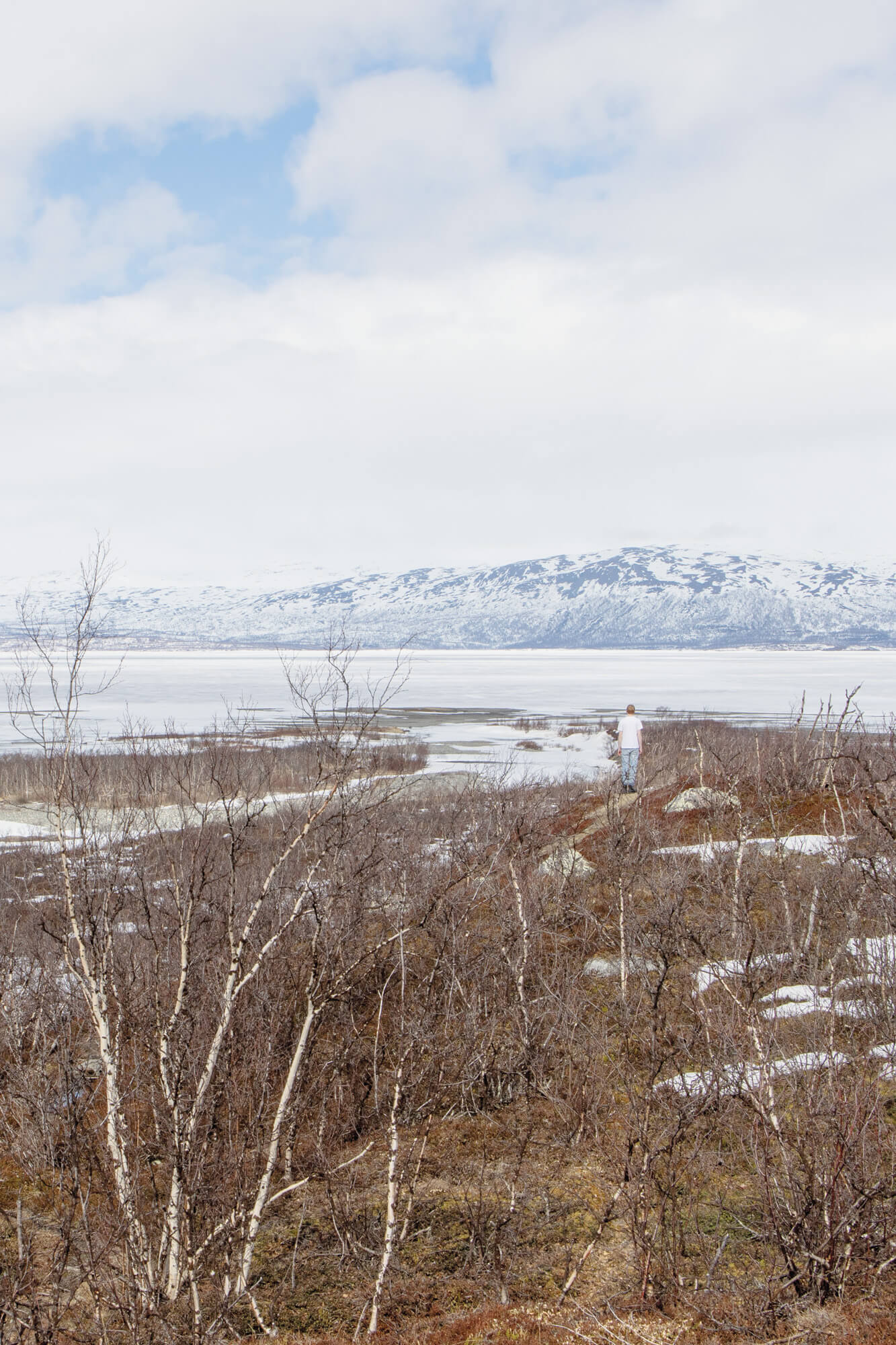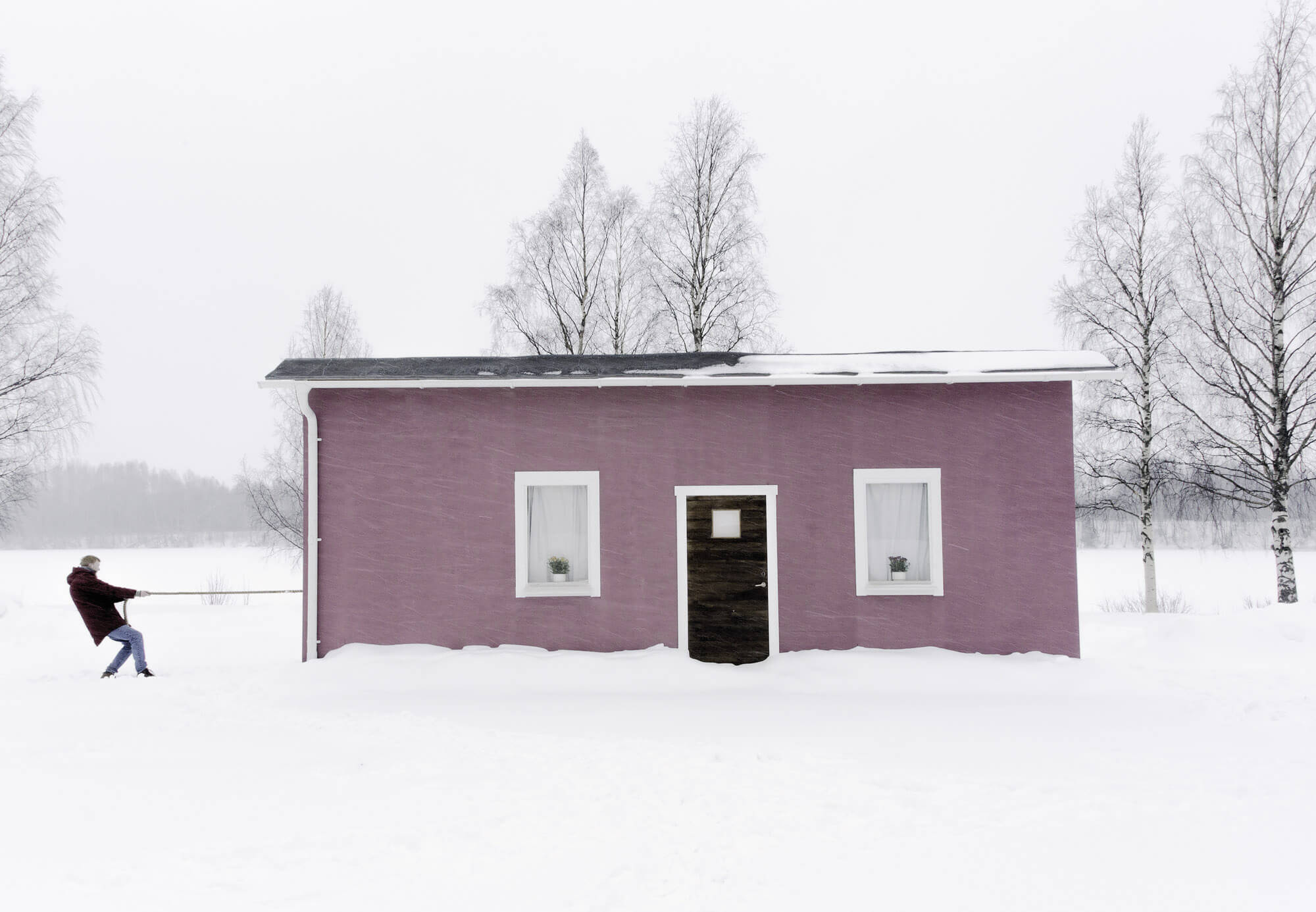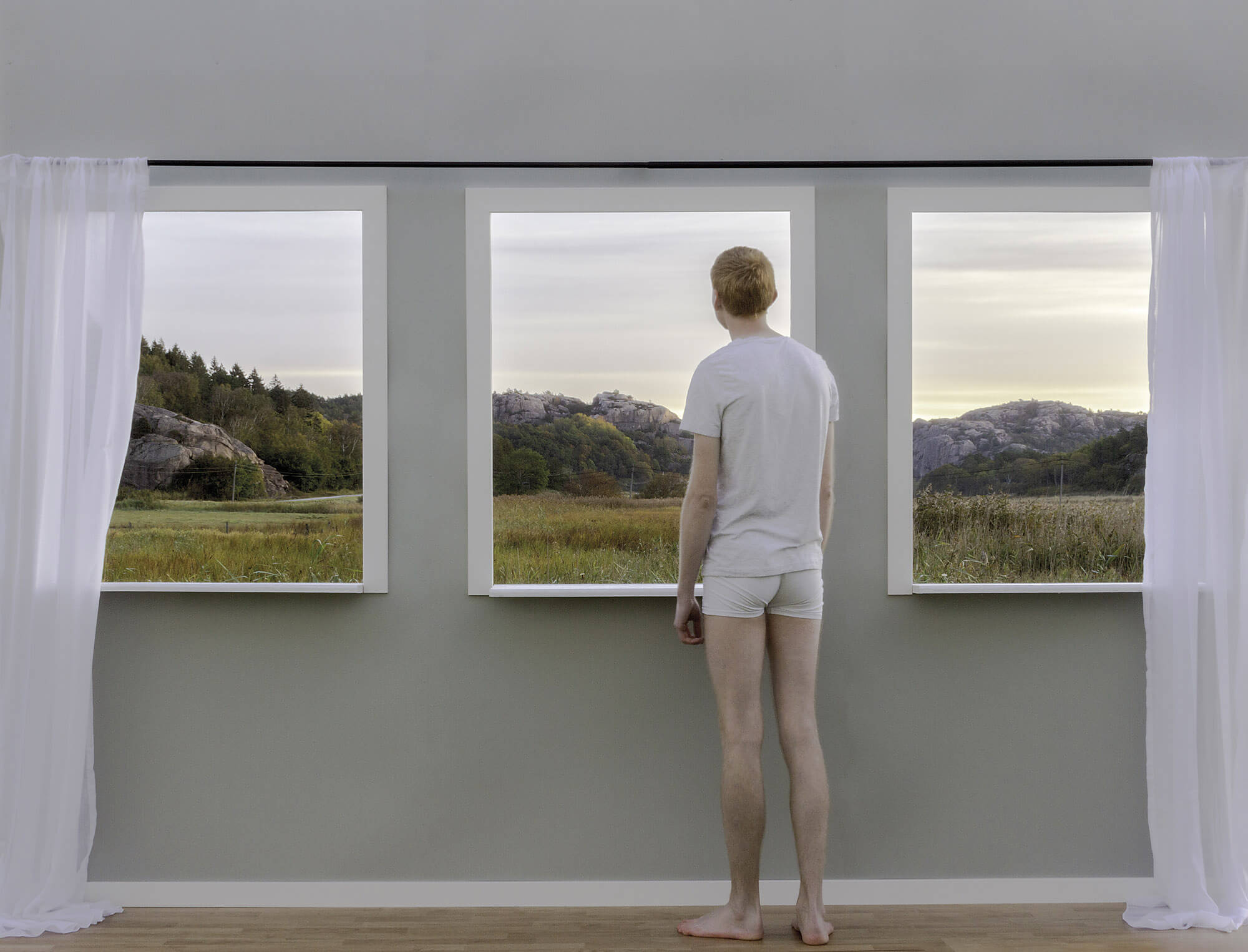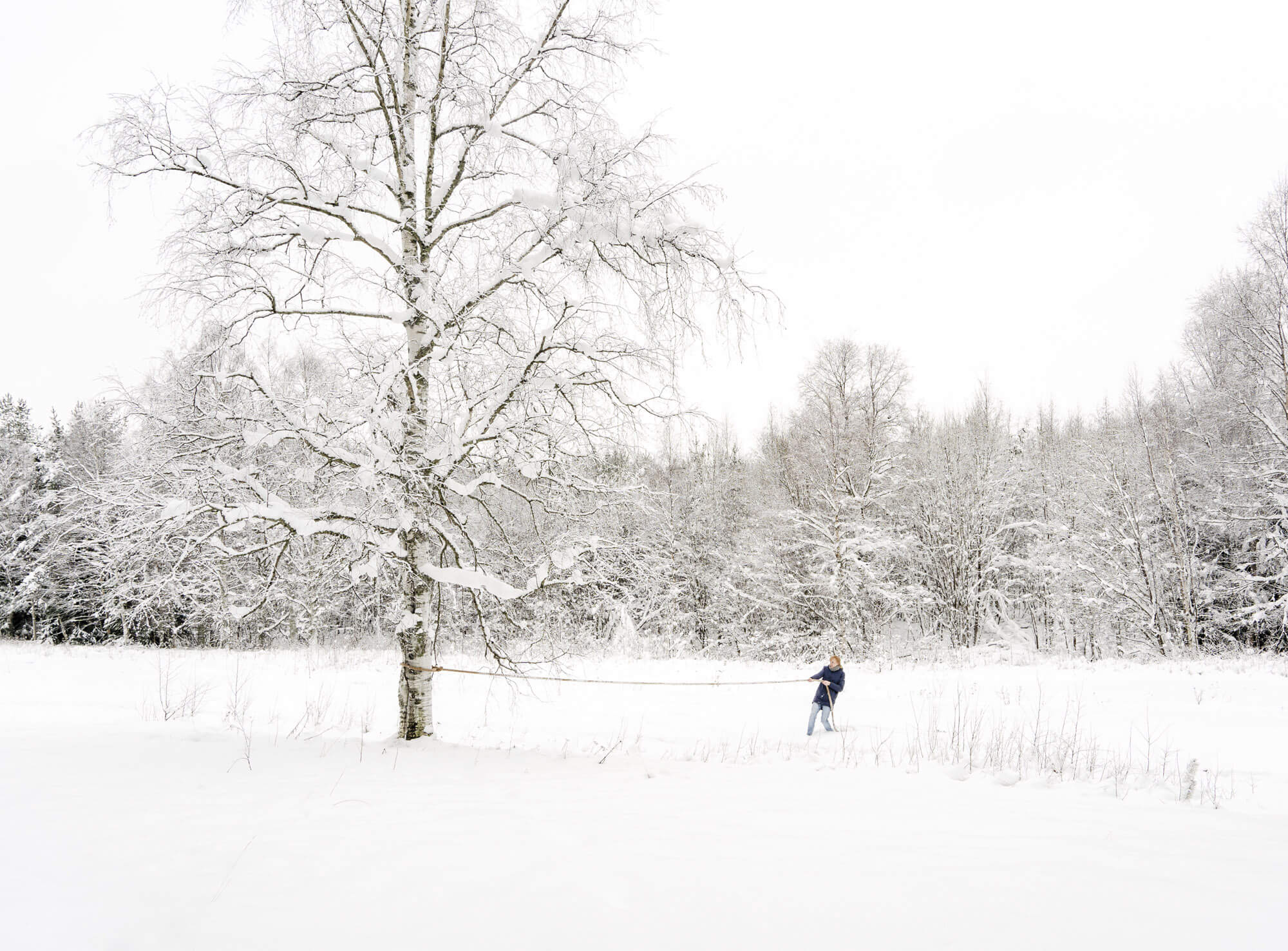Entrance
Peter StridsbergBio
Fascinated by how the concept of landscape has evolved over time and the way it influences how we
see and feel a place, Peter Stridsberg reflects on the physical and mental dynamics triggered by
the encounter between human and natural dimensions.
In the installation conceived for this exhibition, the artist combines his artistic practice
with his explorations of recent years, where human beings, the landscape and mountains meet.
Seated on the sofa, the temporary inhabitant of this room can turn his/her gaze to the mountain
landscape present in the video, or the one portrayed in the photograph. In doing so, the
fictious encounter between the urban dimension and the natural context is evoked.
The work directly brings into play the condition of forced isolation experienced during the
pandemic period, the sense of the impossible and, equally, the perceived need to be in direct
contact with natural and outdoor environments, such as mountain spaces or city parks.
In this sense, his work makes reference to two highly topical themes: “nature-deficit disorder”
and “solastalgia”, both negative reactions generated by biological annihilation and the
progressive extinction of experiences with nature.
These conditions are part of the wider universe of those that have been indicated as
“psychoterratic mental conditions” to describe emotional disorders – such as eco-anxiety and
global fear – deriving from the sudden change in the state of health of the Earth and its
ecosystems.
Peter Stridsberg
I will show you how the mountains move under our feet when the clouds stretch
from the cloud cover's unfiltered light gaze, 2024
Photography on printed glass
Courtesy the artist
Benefits of “Mediated Nature”
The first scientific studies on the influence of nature and vegetation on health were the
work of Professor Roger S. Ulrich, who conducted several experiments in the 1980s to
detect the effects of exposure to natural elements on recovery from stress and on
healing processes.
In one of his pioneering studies, Ulrich showed that patients who had a view of a garden
from their post-operatory hospital room had a far better outcome in terms of recovery
time, complications and drug administration than those who did not have a view of a
green space.1
Similar results were obtained in experiments conducted in prison, where cells with a
view onto green space and trees were generally associated with a smaller number of
healthcare calls by prisoners.2
Numerous subsequent studies have confirmed Professor Ulrich’s results on different types
of patients, confirming the ability of exposure to the natural environment – via
photographs, videos or wall paintings – to improve emotional states, health and recovery
from illness, as well as increasing pain tolerance.3-5
Patient reactions linked to the presence of plants in medical in-patient/diagnostic
screening environments are no less impressive. Patients operated on for thyroidectomy
and appendectomy, to provide but an example, were found to have a greater tolerance of
pain and, as a result, required minor recourse to painkillers, as well as being less
anxious when plants were present in their hospital room.6, 7
Similar results have also been obtained in healthy subjects with artificially induced
pain.8
Ulrich was also the first academic to demonstrate that just visualising images of
forests prompts improvement in certain physiological parameters (blood pressure, alpha
brainwave amplitude, muscular tension).9
Today, multiple studies demonstrate restorative effects and a reduction of stress linked
to even indirect exposure to natural environments, i.e. via various types of “nature
substitutes” such as photos, videos and virtual natural environments.10-13 Although “technological nature” cannot, of course,
completely reproduce the effects of real nature and lacks many major advantages of
forest immersion, virtual “immersive” technologies might be important for improving the
well-being of people with no direct access to nature or for whom direct contact with
nature is not possible or indeed hazardous. This applies primarily to subjects with
physical disabilities or in situations of bedrest and treatment but also to certain
forms of mental illness, including pathological depression and anxiety.
— Francesco Meneguzzo, Federica Zabini
Institute of BioEconomy, CNR - Sesto Fiorentino (FI) CAI Central Scientific Committee
- R. Ulrich, "View through a window may influence recovery from surgery", Science, 224, 1984. pp. 420–421.
- E. O. Moore, "A prison environment’s effect on health care service demands", Journal of Environmental Systems, 11, 1981, pp. 17-34.
- K. Guidolin, F. Jung, S. Hunter, H. Yan, M. Englesakis, S. Verderber, S. Chadi, F. Quereshy, "The Influence of Exposure to Nature on Inpatient Hospital Stays: A Scoping Review", Health Environments Research and Design Journal, 2024. LINK→
- G. B. Diette, N. Lechtzin, E. Haponik, A. Devrotes, H.R. Rubin, "Distraction therapy with nature sights and sounds reduces pain during flexible bronchoscopy: a complementary approach to routine analgesia", Chest., 123(3), 2003, 941-8. LINK→
- Pearson, Michelle, et al., "The Physiological Impact of Window Murals on Pediatric Patients", Health Environments Research & Design Journal, 12(2), 2019, 116–29. LINK→
- S. Park, R. Mattson, "Effects of flowering and foliage plants in hospital rooms on patients recovering from abdominal surgery", HortTechnology, 2008, pp. 563-568.
- S. Park, R. Matttson, "Therapeutic influences of plants in hospital rooms on surgical recovery", HortScience, 2009, pp. 102-105.
- M. Tse, J. Ng, J. Chung, T. Wong, "The effect of visual stimuli on pain threshold and tolerance", Journal of Clinical Nursing, 11, 2002, pp. 462–469.
- R. S. Ulrich, "Natural Versus Urban Scenes: Some Psychophysiological Effects", Environment and Behavior, 13(5), 1981, pp. 523-556. LINK→
- X. Wang, Y. Shi, B. Zhang, Y. Chiang, "The Influence of Forest Resting Environments on Stress Using Virtual Reality", International Journal of Environmental Research and Public Health, 16(18), 2019. LINK→
- C. Song, H. Ikei, Y. Miyazaki, "Physiological effects of visual stimulation with forest imagery", International Journal of Environmental Research and Public Health, 15(2), 2018. LINK→
- H. Jo, C. Song, Y. Miyazaki, "Physiological benefits of viewing nature: A systematic review of indoor experiments", International Journal of Environmental Research and Public Health, 16(23), 2019. LINK→
- F. Zabini, L. Albanese, F. Becheri, G. Gavazzi, F. Giganti, F. Giovanelli, G. Gronchi, A. Guazzini, M. Laurino, Q. Li, T. Marzi, F. Mastorci, F. Meneguzzo, S. Righi, M. P. Viggiano, "Comparative Study of the Restorative Effects of Forest and Urban Videos during COVID-19 Lockdown: Intrinsic and Benchmark Values", International Journal of Environmental Research and Public Health, 17(21), 2020. LINK→
Anxious about Climate Change
The climate crisis, one of the greatest challenges of our time, is raising increasing
disquiet and concern. In psychology and the social sciences, these emotional reactions
have been analysed as an expression of eco-anxiety. Eco-anxiety is defined by the
American Psychological Association as a chronic fear of environmental doom and a
generalised sense that the ecological foundations of human existence are collapsing. It
is a complex feeling that stems from the perception of an increasingly unsustainable
future that creates uncertainty. Fear, worry, guilt and anguish are just some of the
emotions associated with eco-anxiety. Although this type of anxiety is not identified as
a real pathology, many empirical studies show that it can have major impacts on mental
health, especially among younger people (18-35 years old), women and in those countries
of the Global South that are already significantly exposed to environmental
catastrophes.
In our region as well, where the effects of climate change are already visible, there is
fear of extreme weather events. In a joint research project, Eurac Research and the
Provincial Institute for Statistics ASTAT have analysed the emotional reactions of the
South Tyrolean population to the climate crisis. The results speak clearly: also in
South Tyrol, people are dealing with eco-anxiety. Indeed, 70% of the sample stated that
they are afraid, 80% feel concerned, 39% feel guilty and 67% feel powerless. The South
Tyrolean population is particularly worried about risks related to droughts, water
shortages and floods.
How can eco-anxiety be addressed? Firstly, and most importantly, governments need to
take more ambitious measures to tackle the climate crisis, also by involving the
population through participatory processes. This could reduce the widespread feeling of
powerlessness related to policy inaction. Secondly, it might become more important to
develop new emotional skills to deal with eco-anxiety, as it is not going to disappear
anytime soon. Therefore, psychological support services should be implemented that
acknowledge the effects of eco-anxiety on mental health and help people transform the
disabling feeling of eco-anxiety into a proactive attitude for social and ecological
change.
— Ilaria De March, Felix Windegger, Christoph Kircher
Center for Advanced Studies, Eurac Research – Bolzano (BZ)



